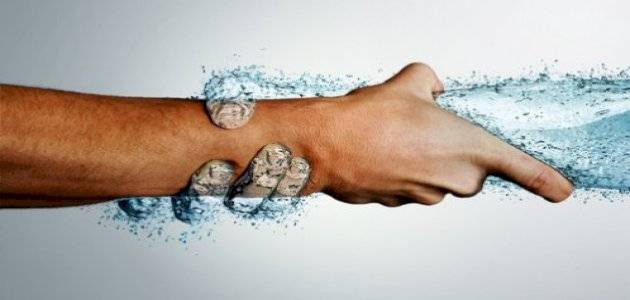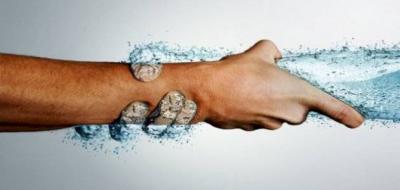Dehydration occurs when a person loses more fluids than they take in, resulting in an insufficient amount of water in the body to replace the lost fluids. In addition to feelings of thirst, a decrease in urine volume with a darker yellow color, difficulty swallowing, constipation, nausea, physical fatigue, blurred vision, the body sends several other warning signs when dehydration occurs. Some of these may be unexpected, such as:
1. **Unexpected Bad Breath**: Saliva works around the clock to eliminate food particles that accumulate on the tongue, between teeth, and along the gums after eating. If the mouth is dry, these small food remnants allow bacteria to grow, causing bad breath, which is one of the signs of dehydration. The first thought that should come to mind regarding bad breath is the likelihood of dehydration. Saliva has antibacterial properties, but dehydration can prevent the body from producing enough saliva. John Higgins, a professor of medicine at the University of Texas in Houston, states, “If you are not producing enough saliva, there can be a bacterial overgrowth in the mouth, one side effect of which is bad breath.” This same mechanism is responsible for morning breath upon waking since saliva production slows during sleep, as noted by Mayo Clinic doctors.
2. **Increased Cravings for Sweets**: One of the strongest reasons for craving sugars and sweets is body dehydration. Medical sources indicate that “sugar craving” has several causes, such as stress, accustomed overconsumption of sugars, and digestive disorders, but dehydration remains the predominant factor triggering the desire for sweets. In cases of dehydration, the body becomes confused between the desire to drink water and the urge to eat sweets or hunger pangs, often leading some to crave sweets instead of drinking water. Researchers do not have a definitive explanation for this, but they suggest it may be related to the effect of dehydration on the brain's nerve centers associated with hunger and the desire for sweets. Others point to the possibility that it relates to a disturbance in the sugar taste buds on the tongue when dehydration occurs in the body and mouth. A third explanation is that, with decreased water in the body, it becomes challenging to metabolize glycogen for energy, leading our bodies to crave sugar for a quick energy source, while the actual need is to drink more water. Professor Higgins notes, “When you are dehydrated, it can be difficult for organs like the liver, which uses water, to release glycogen and other components from your energy stores, so you may indeed feel intense cravings for food, especially sweets, because your body struggles to break down glycogen to release glucose into the bloodstream for use as fuel.”
3. **Headaches and Back Pain**: Dehydration is a common and significant cause of various types of headaches. Even mild dehydration can trigger what is known as a “dehydration headache.” Dehydration headache is one type of secondary headache resulting from insufficient water in the body. Dehydration may also provoke migraine headaches, often characterized by a throbbing sensation on one side of the head, accompanied by nausea, vomiting, and sensitivity to light and sound. Additionally, dehydration may lead to tension headaches, which feel like tightness or pressure around the head. A dehydration headache can feel dull, with pain occurring in the front, back, sides, or all around the head. Unlike sinus headaches, a person with a dehydration headache is unlikely to experience facial pain or pressure. It is also unlikely for pain to occur in the back of the neck, as can happen with tension headaches. Several medical explanations link dehydration to different types of headaches. One explanation is that when the body is dehydrated, the brain may temporarily shrink due to fluid loss, as do the blood vessels, causing the brain to pull away from the membranes surrounding it, leading to pain and a dehydration headache. Once rehydrated, the brain swells back to its normal state, relieving the headache. Although various factors besides dehydration can cause headaches, drinking a full glass of water and continuing to hydrate throughout the day is a simple way to alleviate pain if dehydration is indeed the cause.
4. **Lower Back Pain**: A common reason for muscle and joint pain, especially in the lower back, is dehydration. Even mild dehydration can exacerbate back pain and joint or muscle issues in those who already have problems in those areas. The spine consists of 24 vertebrae that protect the spinal cord, along with discs between each vertebra. These discs, described as cushions between the vertebrae, contain a fibrous outer structure surrounding gel-like materials. Water makes up the majority of these discs, making them water cushions that smooth and ease vertebral movement, especially in the lower back. Therefore, when dehydration occurs, these discs are quickly affected, losing water content, shrinking, and losing elasticity, failing to adequately cushion the effects of spinal movement. This can be a root cause of pain in the lower, middle, upper back, and even the neck. Multiple small joints connect the vertebrae to each other and to the pelvic bones, and their flexibility significantly diminishes with dehydration. Water constitutes 80 percent of body muscle mass. Even mild to moderate dehydration can lead to muscle pain, while severe dehydration can cause cramps and muscle spasms. All these factors worsen issues related to back pain, affecting the discs between bony vertebrae, the joints, and the muscles connected to them.
5. **Mood Swings**: In a study by researchers at the Human Performance Laboratory at the University of Connecticut, mood state and focus were tested in women who drank healthy amounts of water on one day and not on the following two days. Experiencing mild dehydration, the women reported feelings of fatigue, bad mood, headaches, and difficulty concentrating. In a separate test, men with mild dehydration also faced fatigue and cognitive task issues. However, when it came to mood changes, women's stress levels were significantly higher than men's, according to the study. Water makes up 60 percent of brain weight, making the brain one of the most vital organs requiring hydration, as it is the center of thought and other mental capabilities and sends signals to the body for basic movements and processes. A study on the relationship between dehydration and driving ability examined dehydration's effects on brain function. It was found that dehydrated drivers exhibited driving patterns similar to those under the influence of alcohol. Unnecessary lane changes and delayed reaction times were just two major issues arising from dehydration while driving. Additionally, there is a level of muscle fatigue that accompanies dehydration, which can be detrimental on the road, at work, and in daily life. Other studies have shown that dehydration can worsen a person's perception of pain. It is unclear why this occurs, but when the brain is dehydrated, the body may experience elevated pain levels in the forms of headaches, muscle pain, joint pain, back pain, and more. So, if someone deals with pain on a daily basis without any direct health issue, they may need to increase hydration levels to experience a reduction in pain.
### Varying Degrees of Dehydration
As the amount of fluids in the body decreases, several signs of dehydration appear. The severity of these signs varies based on the degree of dehydration, the cause, the individual's health condition, and age. Medical fields classify dehydration into three degrees:
- Mild dehydration: causing a loss of 1 to 3 percent of body weight.
- Moderate dehydration: causing a loss of 4 to 6 percent of body weight.
- Severe dehydration: causing a loss of more than 6 percent of body weight.
An additional indicator of mild dehydration is the “Capillary Refill Time” test. This test involves pressing a fingertip until it turns white (a few minutes), then releasing pressure and observing how long it takes to return to its normal pink color. In mild dehydration cases, this time is under 2 seconds. In moderate dehydration cases, it takes between 2 to 4 seconds.
There is also a third indicator for evaluating the degree of dehydration, which is the “Skin Turgor” test. This involves pinching the skin on the back of the hand and observing how easily that occurs and the time needed for it to return to its normal state. In mild dehydration conditions, the skin returns to normal within less than 2 seconds in an average-aged person. In moderate dehydration cases, it may take up to 10 seconds.




